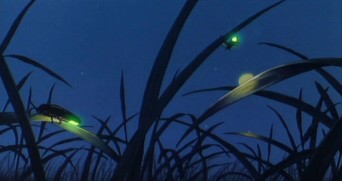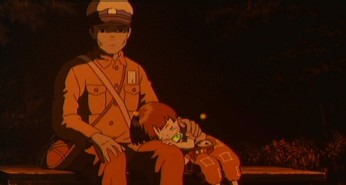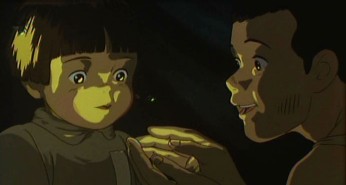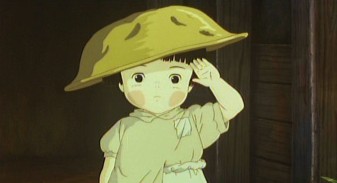And Isao Takahata



P.O. Box 77010 / San Francisco, CA 94107 / �1995 Viz Communications, Inc.


| Interview with NosakaAkiyuki And Isao Takahata |
||||||||||||||||||||||||||||||||||
 |
||||||||||||||||||||||||||||||||||
|
|
||||||||||||||||||||||||||||||||||
| The following text is from the interview with NosakaAkiyuki and Isao Takahata by ANIMAGE Magazine**. This English translation and additional notes were taken and edited without permission from Animerica Anime & Manga Monthly*** Vol.2, No.11. | ||||||||||||||||||||||||||||||||||
|
|
||||||||||||||||||||||||||||||||||
| Nosaka: That brother and sister can only survive that harsh environment by locking themselves up into a world of their own. When they lose their sole guardian, their mother, the older brother decides to become the guardian of his little sister, even if it means making an enemy out of the entire world. He gets to the point where he thinks he wouldn't mind turning himself into nourishment for his sister. On the one hand, that's very tragic, but it's also a very blessed situation. For Seita, it's like he can try to build a heaven for just the two of them....After all, it's a double-suicide story. | ||||||||||||||||||||||||||||||||||
| Takahata: That's true. I felt that very strongly when I first read the book. I felt something in common with Chikamatsu's double-suicide plays. I thought it was that way in its structure, as well. It starts with the premise that the main characters must die, and the story follows the path to their death. Except that I think you were right when you said "heaven." I'd like to depict it that way in the movie, too. | ||||||||||||||||||||||||||||||||||
| Nosaka: In fact, when it comes to reality, that boy isn't such a romanticist. After all, he gets hungry too. But objectively speaking, Setsuko is four years old, the age when a girl looks the cutest. And a fourteen- to fifteen-year-old boy is at the age when he's becoming aware of his masculinity, ergo his ego. That kind of pair heads into a life that includes only the two of them. There's an obvious consanguineous relationship there. The only person he can exchange words with is his sister, but while there's a strong blood-tie, he's shut out from being able to love her as a girl. His tension grows high -- hence a sublimation takes place. | ||||||||||||||||||||||||||||||||||
 |
||||||||||||||||||||||||||||||||||
| The sister too, becomes affected by the change in the environment and the change in her brother, and has to grow up quickly. Eventually, she assumes the role of his mother at times, and at other times, the role of his lover. She is overwhelmingly dependent on him, but she also becomes his spiritual support. So when the sister starts to perish physically, the brother has no choice but to see her as becoming even more beautiful. It's like the sweet delusions of boyhood. In the end, it turns out that the days leading up to their death are like the development of a love story. | ||||||||||||||||||||||||||||||||||
| I wrote this book in 1967, right in the middle of Japan's high economic growth years. From my perspective it looked like an abnormal time. I thought the real spirit of humanity was different, and I wanted to depict the idealized humanity of a brother and a sister, or, ultimately, of a man and a woman. It's based on my experience, but in that sense, I wanted to place the main character in an idealized situation. I was a naive one myself until the age of fourteen, and thus worse off than other kids, and I had to grow up quickly after being placed in such a situation. I didn't like that one bit. I had to adapt to life every day, so it was like visibly growing up, like watching a video in fast forward. Normally, you'd grow up slowly, after failures and betrayals and facing the apathy of grownups. But I had to go through ten years of that in a month, so everything like the cunning that was latent in me all came up to the surface, in a defiant way. My only support back then was my two-year-old sister. If I was stealing, I could feel it was justified if it was for my sister. When I was rapidly growing up, my feelings about not wanting to grow up, or the guilt that I was doing bad things in the process of growing up, was all compensated for by the existence of my sister. | ||||||||||||||||||||||||||||||||||
| My sister's death is an exact match with the novel. It was one week after the end of the war. At the countryside of Fukui prefecture where I was, it was the day the restrictions on lighting were removed. It must have been the 22nd. It was evening, and I was picking up my sister's bones. I was coming home in a daze when I saw the village lit up. There was nothing like my surprise then. My sister died in my side of the world, and light was coming back in the other. The return of light also implies the return of peace, and at that time, I felt from deep within that I'd survived, which was also very scary. | ||||||||||||||||||||||||||||||||||
 |
||||||||||||||||||||||||||||||||||
|
|
||||||||||||||||||||||||||||||||||
| About the novel: Published in Japan during 1967 in BungeiShunju's monthly popular-literature magazine OoruYomimono ("All For Reading"), author AkiyukiNosaka'sheartwrenching semi-autobiographical experiences caught the attention of the nation. A year later, Fireflies would win the prestigious Naoki Award for literary achievement, but it would take over twenty years -- April 16, 1988 -- for Nosaka's novel to finally be released in Japan as a theatrical animated feature. | ||||||||||||||||||||||||||||||||||
| About the U.S. release: Central Park Media released an English subtitled version of "Fireflies"; and titled it "Grave of the Fireflies" In addition to winning Japan's Naoki Award (equivalent to the Pulitzer for literature), the animated film based on author Nosaksa's "Fireflies"; won two very important prizes when it was screened at the recent 1994 Chicago International Children's Film Festival. The Festival's international jury awarded "Fireflies" "First Prize in the Rights of the Child" category, a prize which is awarded annually to the film or video that best represents the U.N. Declaration of the Rights of the Child. The Festival's adult animation jury also chose "Fireflies"; as the top film in the "Best Animated Feature Film"; category. | ||||||||||||||||||||||||||||||||||
| **ANIMAGE Magazine, June 1987 issue; reprinted in Isao Takahata'sEiga o Tsukurinagara, Kangaeta Koto and published by TokumaShoten, 1991. | ||||||||||||||||||||||||||||||||||
| ***Animerica Anime & Manga Monthlyis published by Viz Communications, Inc. / P.O. Box 77010 / San Francisco, CA 94107 / �1995 Viz Communications, Inc. |
||||||||||||||||||||||||||||||||||
 |
||||||||||||||||||||||||||||||||||
 |
||||||||||||||||||||||||||||||||||